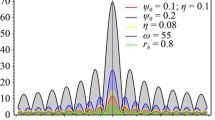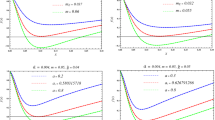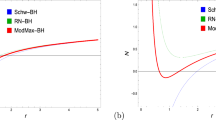Abstract
We investigate Einstein–Gauss–Bonnet–Maxwell massive gravity in 4D AdS background and find an exact black hole solution. The horizon structure of the black holes studied. Treating the cosmological constant as pressure and Gauss–Bonnet coupling parameters, and massive gravity parameters as variables we drive the first law of black hole thermodynamics. To study the global stability of the black holes we compute the Gibbs free energy. The local stability of the black hole is also studied through specific heat. We analyze the effects of graviton mass and Gauss–Bonnet coupling parameters on the phase transition of the black holes. Finally, the effects of graviton mass and massive gravity parameters on the Joule–Thomson expansion of the black hole are studied.



















Similar content being viewed by others
Data Availibility Statement
No Data is associated with the manuscript.
Notes
In order to have a self-consistent massive gravity theory, the coupling parameters \(c_i\) might be required to be negative if the squared mass of the graviton is positive. However, in the AdS spacetime, the coupling parameters \(c_i\) can still take the positive values. This is because the fluctuations of the fields with the negative squared masses in the AdS spacetime could still be stable if their squared masses obey the corresponding Breitenlohner–Freedman bounds.
References
C. Barrabes, G.F. Bressange, Singular hypersurfaces in scalar-tensor theories of gravity. Class. Quant. Grav. 14, 805–824 (1997)
R.-G. Cai, Y.S. Myung, Black holes in the Brans-Dicke-Maxwell theory. Phys. Rev. D 56, 3466–3470 (1997). arXiv:gr-qc/9702037
S. Capozziello, A. Troisi, PPN-limit of fourth order gravity inspired by scalar–tensor gravity. Phys. Rev. D 72, 044022 (2005). arXiv:astro-ph/0507545
T.P. Sotiriou, f(R) gravity and scalar–tensor theory. Class. Quant. Grav. 23, 5117–5128 (2006). arXiv:gr-qc/0604028
J.W. Moffat, Scalar–tensor-vector gravity theory. JCAP 03, 004 (2006). arXiv:grqc/0506021
V. Faraoni. de Sitter space and the equivalence between f(R) and scalar–tensor gravity. Phys. Rev. D 75, 067302 (2007). arXiv:gr-qc/0703044
D. Lovelock, The Einstein tensor and its generalizations. J. Math. Phys. 12, 498–501 (1971)
D. Lovelock, The four-dimensionality of space and the Einstein tensor. J. Math. Phys. 13, 874–876 (1972)
N. Deruelle, L. Farina-Busto, The lovelock gravitational field equations in cosmology. Phys. Rev. D 41, 3696 (1990)
T. Tangphati et al., Anisotropic stars in 4D Einstein. Gauss. Bonnet gravity. Phys. Dark Univ. 33, 100877 (2021)
J.M.Z. Pretel, A. Banerjee, A. Pradhan, Electrically charged quark stars in 4D Einstein. Gauss. Bonnet Grav. Eur. Phys. J. C 82, 180 (2022)
T. Tangphati et al., Anisotropic quark stars in Einstein–Gauss–Bonnet theory. Phys. Lett. B 819, 136423 (2021)
T. Tangphati et al., Anisotropic quark stars in Einstein–Gauss–Bonnet theory. Phys. Lett. B 819, 136423 (2021)
J.M. Cline, H. Firouzjahi, Brane world cosmology of modulus stabilization with a bulk scalar field. Phys. Rev. D 64, 023505 (2001). arXiv:hep-ph/0005235
T. Nihei, N. Okada, O. Seto, Neutralino dark matter in brane world cosmology. Phys. Rev. D 71, 063535 (2005). arXiv:hep-ph/0409219
M. Demetrian, False vacuum decay in a brane world cosmological model. Gen. Rel. Grav. 38, 953–962 (2006). arXiv:gr-qc/0506028
C. Lanczos, A Remarkable property of the Riemann–Christoffel tensor in four dimensions. Ann. Math. 39, 842–850 (1938)
D. Glavan, C. Lin, Einstein–Gauss–Bonnet gravity in four-dimensional spacetime. Phys. Rev. Lett. 124(8), 081301 (2020)
P.G.S. Fernandes, Charged black holes in AdS spaces in 4D Einstein Gauss–Bonnet gravity. Phys. Lett. B 805, 135468 (2020)
P.G.S. Fernandes et al, The 4D Einstein–Gauss–Bonnet theory of gravity: a review. Class. Quant. Grav. 39(6), 063001 (2022). arXiv:2202.13908 [gr-qc]
K. Hegde et al., Thermodynamics, phase transition and joule thomson expansion of novel 4-D Gauss Bonnet AdS black hole (2020). arXiv:2003.08778 [gr-qc]
S-W Wei, Y-X Liu, Extended thermodynamics and microstructures of four-dimensional charged Gauss–Bonnet black hole in AdS space. Phys. Rev. D 101(10), 104018 (2020). arXiv: 2003.14275 [gr-qc]
Y.-Y. Wang, B.-Y. Su, N. Li. Hawking–Page phase transitions in four-dimensional Einstein–Gauss–Bonnet gravity. Phys. Dark Univ. 31, 100769 (2021). arXiv:2008.01985 [gr-qc]
D.V. Singh, S.G. Ghosh, S.D. Maharaj, Clouds of strings in 4D Einstein–Gauss–Bonnet black holes. Phys. Dark Univ. 30, 100730 (2020). arXiv:2003.14136 [gr-qc]
D.V. Singh, S. Siwach, Thermodynamics and P-v criticality of Bardeen-AdS Black Hole in 4D Einstein–Gauss–Bonnet gravity. Phys. Lett. B 808, 135658 (2020). arXiv:2003.11754 [gr-qc]
B. Eslam Panah, K. Jafarzade, S.H. Hendi, Charged 4D Einstein–Gauss–Bonnet-AdS black holes: shadow, energy emission, deflection angle and heat engine. Nucl. Phys. B 961, 115269 (2020). arXiv:2004.04058 [hep-th]
D.V. Singh, B.K. Singh, S. Upadhyay, 4D AdS Einstein–Gauss–Bonnet black hole with Yang–Mills field and its thermodynamics. Ann. Phys. 434, 168642 (2021). arXiv:2203.03861 [gr-qc]
N. Godani, D.V. Singh, G.C. Samanta, Stability of thin-shell wormhole in 4D Einstein–Gauss–Bonnet gravity. Phys. Dark Univ. 35, 100952 (2022)
S.H. Hendi, S. Panahiyan, Thermodynamic instability of topological black holes in Gauss– Bonnet gravity with a generalized electrodynamics. Phys. Rev. D 90(12), 124008 (2014). arXiv: 1501.05481 [gr-qc]
K. Yang et al, Born–Infeld black holes in 4D Einstein–Gauss–Bonnet gravity. Eur. Phys. J. C 80(7), 662 (2020). arXiv:2004.14468 [gr-qc]
S.G. Ghosh et al., Phase transition of AdS black holes in 4D EGB gravity coupled to nonlinear electrodynamics. Ann. Phys. 424, 168347 (2021). arXiv:2006.00594 [gr-qc]
S.I. Kruglov, Einstein–Gauss–Bonnet gravity with rational nonlinear electrodynamics. EPL 133(6), 6 (2021). arXiv:2106.00586 [physics.gen-ph]
S.I. Kruglov, 4D Einstein–Gauss–Bonnet gravity coupled with nonlinear electrodynamics. Symmetry 1(2), 24–204 (2021)
S.I. Kruglov, Einstein–Gauss–Bonnet gravity with nonlinear electrodynamics: entropy, energy emission. Quasinormal modes and deflection angle. Symmetry 13(6), 944 (2021)
S.I. Kruglov, New model of 4D Einstein–Gauss–Bonnet gravity coupled with nonlinear electrodynamics. Universe 7, 249 (2021). arXiv:2108.07695 [physics.gen-ph]
S.I. Kruglov, Einstein–Gauss–Bonnet gravity with nonlinear electrodynamics. Ann. Phys. 428, 168449 (2021). arXiv:2104.08099 [gr-qc]
D.V. Singh, V.K. Bhardwaj, S. Upadhyay, Thermodynamic properties, thermal image and phase transition of Einstein–Gauss–Bonnet black hole coupled with nonlinear electrodynamics. Eur. Phys. J. Plus 137(8), 969 (2022). arXiv:2208.13565 [gr-qc]
B.P. Abbott et al., Tests of general relativity with GW150914. Phys. Rev. Lett. 116(22) (2016). [Erratum: Phys.Rev.Lett. 121, 129902 (2018)], p. 221101. arXiv:1602.03841 [gr-qc]
M. Fierz, W. Pauli, On relativistic wave equations for particles of arbitrary spin in an electromagnetic field. Proc. R. Soc. Lond. A 173, 211–232 (1939)
M. Fierz, Force-free particles with any spin. Helv. Phys. Acta 12, 3–37 (1939)
D.G. Boulware, S. Deser, Can gravitation have a finite range? Phys. Rev. D 6, 3368–3382 (1972)
C. de Rham, G. Gabadadze, Generalization of the Fierz–Pauli action. Phys. Rev. D 82, 044020 (2010). arXiv:1007.0443 [hep-th]
C. de Rham, G. Gabadadze, A.J. Tolley, Resummation of massive gravity. Phys. Rev. Lett. 106, 231101 (2011). arXiv:1011.1232 [hep-th]
S.H. Hendi, S. Panahiyan, B. Eslam Panah, Charged black hole solutions in Gauss–Bonnet–Massive gravity. JHEP 01, 129 (2016). arXiv:1507.06563 [hep-th]
S.H. Hendi, B. Eslam Panah, S. Panahiyan, Thermodynamical structure of AdS black holes in massive gravity with stringy gauge-gravity corrections. Class. Quant. Grav. 33(23), 235007 (2016). arXiv: 1510.00108 [hep-th]
S.H. Hendi et al., Charged BTZ black holes in the context of massive Gravity’fs rainbow. Phys. Rev. D 95(8), 084036 (2017). arXiv:1611.02937 [hep-th]
S. Upadhyay et al., Thermal fluctuations of charged black holes in gravity’fs rainbow. PTEP 2018 9, 093E01 (2018). arXiv:1809.01078 [gr-qc]
S.H. Hendi, M. Momennia, Thermodynamic description and quasinormal modes of adS black holes in Born–lnfeld massive gravity with a non-abelian hair. JHEP 10, 207 (2019). arXiv: 1801.07906 [gr-qc]
B.K. Singh, R.P. Singh, D.V. Singh, Extended phase space thermodynamics of Bardeen black hole in massive gravity. Eur. Phys. J. Plus 135(10), 862 (2020). arXiv:2004.11023 [gr-qc]
S. Upadhyay, D.V. Singh, Black hole solution and thermal properties in 4D AdS Gauss–Bonnet massive gravity. Eur. Phys. J. Plus 137(3), 383 (2022). arXiv:2206.12257 [gr-qc]
S.W. Hawking, D.N. Page, Thermodynamics of black holes in anti-de sitter space. Commun. Math. Phys. 87, 577 (1983)
S. Wang et al., The First laws of thermodynamics of the (2+1)-dimensional BTZ black holes and Kerr-de Sitter spacetimes. Chin. Phys. Lett. 23, 1096–1098 (2006). arXiv:hep-th/0601147
D. Kastor, S. Ray, J. Traschen, Enthalpy and the Mechanics of AdS Black Holes. Class. Quant. Grav. 26, 195011 (2009). arXiv:0904.2765 [hep-th]
D. Kastor, S. Ray, J. Traschen, smarr formula and an extended first law for lovelock gravity. Class. Quant. Grav. 27, 235014 (2010). arXiv: 1005.5053 [hep-th]
B.P. Dolan, The cosmological constant and the black hole equation of state. Class. Quant. Grav. 28, 125020 (2011). arXiv:1008.5023 [gr-qc]
B.P. Dolan, Pressure and volume in the first law of black hole thermodynamics. Class. Quant. Grav. 28, 235017 (2011). arXiv:1106.6260 [gr-qc]. 25
D. Kubiznak, R.B. Mann, P-V criticality of charged AdS black holes. JHEP 07, 033 (2012). arXiv:1205.0559 [hep-th]
S. Gunasekaran, R.B. Mann, D. Kubiznak, Extended phase space thermodynamics for charged and rotating black holes and Born–Infeld vacuum polarization. JHEP 11, 110 (2012). arXiv:1208.6251 [hep-th]
Ö. ÖkcÜu, E. Aydner, Joule–Thomson expansion of the charged AdS black holes. Eur. Phys. J. C 77(1), 24 (2017). arXiv:1611.06327 [gr-qc]
Ö. ÖkcÜu, E. Aydner, Joule–Thomson expansion of Kerr–AdS black holes. Eur. Phys. J. C 78(2), 123 (2018). arXiv:1709.06426 [gr-qc]
S. Capozziello, G.G.L. Nashed, Rotating and non-rotating AdS black holes in f(T ) gravity non-linear electrodynamics. Eur. Phys. J. C 79(11), 911 (2019). arXiv:1908.07381 [gr-qc]
G.G.L. Nashed, S. Capozziello, Charged Anti-de Sitter BTZ black holes in Maxwell-f(T) gravity. Int. J. Mod. Phys. A 33(13), 1850076 (2018). arXiv:1710.06620 [gr-qc]
G.G.L. Nashed, S. Capozziello, Charged spherically symmetric black holes in f(R) gravity and their stability analysis. Phys. Rev. D 99(10), 104018 (2019). arXiv:1902.06783 [gr-qc]
C.H. Nam, Effect of massive gravity on Joule-Thomson expansion of the charged AdS black hole. Eur. Phys. J. Plus 135(2), 259 (2020)
R.-G. Cai et al., Thermodynamics of black holes in massive gravity. Phys. Rev. D 91(2), 024032 (2015). arXiv:1409.2369 [hep-th]
C.H. Nam, Effect of massive gravity on Joule–Thomson expansion of the charged AdS black hole. Eur. Phys. J. Plus 135(2), 259 (2020)
B.F. Schutz, C.M. Will, Black hole normal modes: a semianalytic approach. Astrophys. J. 291, L33–L36 (1985)
S. Iyer, C.M. Will, Black hole normal modes: a WKB approach. 1. Foundations and application of a higher order WKB analysis of potential barrier scattering. Phys. Rev. D 35, 3621 (1987)
R.A. Konoplya, Quasinormal behavior of the d-dimensional Schwarzschild black hole and higher order WKB approach. Phys. Rev. D 68, 024018 (2003). arXiv:gr-qc/0303052
S. Fernando, Phase transitions of black holes in massive gravity. Mod. Phys. Lett. A 31(16), 1650096 (2016). arXiv:1605.04860 [gr-qc]
B.-Y. Su, Y.-Y. Wang, N. Li, The Hawking–Page phase transitions in the extended phase space in the Gauss–Bonnet gravity. Eur. Phys. J. C 80(4), 305 (2020). arXiv:1905.07155 [gr-qc]
A. Rajagopal, D. Kubizn’Lak, R.B. Mann, Van der Waals black hole. Phys. Lett. B 737, 277–279 (2014). arXiv:1408.1105 [gr-qc]
J.-X. Mo et al, Joule–Thomson expansion of d-dimensional charged AdS black holes. Phys. Rev. D 98(12), 124032 (2018). arXiv:1804.02650 [gr-qc]
Z.-W. Zhao, Y.-H. Xiu, N. Li, Throttling process of the Kerr–Newman–anti-de Sitter black holes in the extended phase space. Phys. Rev. D 98(12), 124003 (2018). arXiv:1805.04861 [gr-qc]
C.-M. Zhang, M. Zhang, D.-C. Zou, Joule–Thomson expansion of Born–Infeld AdS black holes in consistent 4D Einstein–Gauss–Bonnet gravity. Mod. Phys. Lett. A 37(11), 2250063 (2022). arXiv:2106.00183 [hep-th]
Acknowledgements
D.V.S. thanks University Grant Commission for the Start-Up Grant No. 30-600/2021(BSR)/1630.
Author information
Authors and Affiliations
Corresponding author
Appendix
Appendix
The Ricci and Kretschmann scalar for the metric function (2.11) are given by
where we use \(f(r)= e^{2A(r)}\), \(f_{rr}(r)\) stands for \(d^2f(r)/dr^2\) and \(f_r(r)\) stands for df(r)/dr.
The differentiation of f(r) with respect to r is given by
Therefore, using (.2) and (.3), Ricci and Kretschmann scalar are given by
In Fig. 20, Kretschmann scalar is plotted. From the figure, it is clear that 4D Einstein–Gauss–Bonnet massive gravity black hole has a true singularity at \(r=0\).
Rights and permissions
Springer Nature or its licensor (e.g. a society or other partner) holds exclusive rights to this article under a publishing agreement with the author(s) or other rightsholder(s); author self-archiving of the accepted manuscript version of this article is solely governed by the terms of such publishing agreement and applicable law.
About this article
Cite this article
Paul, P., Upadhyay, S. & Singh, D.V. Charged AdS black holes in 4D Einstein–Gauss–Bonnet massive gravity. Eur. Phys. J. Plus 138, 566 (2023). https://doi.org/10.1140/epjp/s13360-023-04176-x
Received:
Accepted:
Published:
DOI: https://doi.org/10.1140/epjp/s13360-023-04176-x





